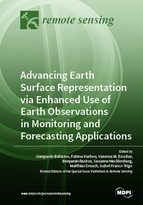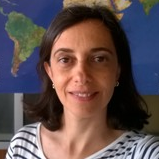Advancing Earth Surface Representation via Enhanced Use of Earth Observations in Monitoring and Forecasting Applications
A special issue of Remote Sensing (ISSN 2072-4292). This special issue belongs to the section "Ocean Remote Sensing".
Deadline for manuscript submissions: closed (31 July 2018) | Viewed by 73113
Special Issue Editors
Interests: earth system modeling; surface-atmosphere interactions, and predictability; climate-change and low-frequency variability; use of remote sensing data in earth system modeling
Interests: land surface/snow remote sensing; surface emissivity; microwave data assimilation; passive and active microwave sensors
Interests: satellite meteorology; remote sensing from infrared and microwave sensors; data assimilation for numerical weather prediction
Interests: land surface hydrology; data assimilation; numerical weather forecasting; remote sensing; space system engineering; fluorescence
Special Issues, Collections and Topics in MDPI journals
Interests: remote sensing; land surface temperature; land surface modelling
Special Issues, Collections and Topics in MDPI journals
Special Issue Information
Dear Colleagues,
The Earth surface modelling community has recognized the need for enhancing the use of Earth Observation (EO) in particular from remote sensing global observing satellites to support and improve the monitoring and understanding of surface processes as complex and intertwined components of the Earth system including land, vegetation, snow, ice, coastal and open waters. A special issue of Remote Sensing attached to a first International surface workshop (http://cimss.ssec.wisc.edu/iswg/meetings/2017/) will be gathering advances in observing/modelling surfaces (land, water and ice) in particular focusing on satellite-based estimation of soil moisture, snow, land surface temperature and surface water body extents.
Dr. Gianpaolo Balsamo
Dr. Fatima Karbou
Dr. Vanessa M. Escobar
Dr. Benjamin Ruston
Dr. Susanne Mecklenburg
Dr. Matthias Drusch
Dr. Isabel Franco Trigo
Guest Editors
Related Reference
Orth, R.; Dutra, E.; Trigo, I.F.; Balsamo, G. Advancing land surface model development with satellite-based Earth observations, Hydrol. Earth Syst. Sci. 2017, 21, 2483–2495.
Manuscript Submission Information
Manuscripts should be submitted online at www.mdpi.com by registering and logging in to this website. Once you are registered, click here to go to the submission form. Manuscripts can be submitted until the deadline. All submissions that pass pre-check are peer-reviewed. Accepted papers will be published continuously in the journal (as soon as accepted) and will be listed together on the special issue website. Research articles, review articles as well as short communications are invited. For planned papers, a title and short abstract (about 100 words) can be sent to the Editorial Office for announcement on this website.
Submitted manuscripts should not have been published previously, nor be under consideration for publication elsewhere (except conference proceedings papers). All manuscripts are thoroughly refereed through a single-blind peer-review process. A guide for authors and other relevant information for submission of manuscripts is available on the Instructions for Authors page. Remote Sensing is an international peer-reviewed open access semimonthly journal published by MDPI.
Please visit the Instructions for Authors page before submitting a manuscript. The Article Processing Charge (APC) for publication in this open access journal is 2700 CHF (Swiss Francs). Submitted papers should be well formatted and use good English. Authors may use MDPI's English editing service prior to publication or during author revisions.
Keywords
- Earth Observations
- Earth Surface Assimilation and Forecasting
- Earth Surface Monitoring








